Agents of Coexistence: A Day In the Field with the CWS Wild Seve Program
Investigating India #9

May 21, 2024 was a thrillingly hectic day. I had hardly returned from the morning safari, the last experience included with my stay at the JLR Kings Sanctuary, when I met up with a team from the Centre for Wildlife Studies. This was the organization where Dr. Krithi Karanth was CEO, which I’d been fascinated by since I’d interviewed her for this newsletter and learned about CWS’ pioneering Wild Seve (human/wildlife conflict management), Wild Shaale (environmental education in local schools) and Wild Surakshe (zoonotic disease prevention) programs. It was a school holiday, so Wild Shaale wasn’t available, but Senior Program Manager Nagachandan Honnur had offered to take me with them on a “day in the life” round of Wild Seve program work. When we met in person, he introduced me to Project Coordinator Dhanush Dev and Field Coordinator “C.K” Chikkaningaiah, and the four of us pored over maps of the region as they gave me more detail on the work I’d first heard of in my interview with Dr. Karanth.
CWS had established a toll-free number for farmers to call when wildlife had caused a problem for them, which connected them straight with Field Coordinator C.K. That kicked off the well-honed Wild Seve conflict management procedure, as C.K. would assess the call and alert the nearest representative of the organization. The next step relied on the field assistants CWS hired from the local communities. The local field assistant knew the area and the people intimately, and did the first-pass assessment of claim cases. They would then summon a broader CWS team, who would collect photo evidence of the wildlife-related conflict, and submit an application for compensation to the Karnataka state government.
The Wild Seve program started in the Nagarahole-Bandipur landscape in 2015, and from 2015 through now in 2024, in just this one landscape, had handled 25,000 wildlife conflict compensation claims for 11,000 individual beneficiaries. (There are more claims than individuals because the farmers who live right on the edge of the forest often have to deal with multiple wildlife conflict issues per person). There were three main categories of conflict claims: property loss (e.g. “elephant stomped my irrigation pipes”), crop loss (e.g. “elephant ate my banana trees”), and livestock loss (e.g. “tiger ate my goat”), plus the rare and dreaded fourth category of human injuries or even death. Wild Seve had been honed to a fine art in its birthplace of Nagarahole, and was still expanding across southern India. As of 2023, Wild Seve was active in 6 parks across the Western Ghats, and was starting in 7 more parks in 2024!
As I worked to construct a mental model of their work, I tried to estimate the human scale. The buffer zone around Nagarahole looked pretty small on the map. Two and five kilometers weren’t very imposing as distances, and Nagarahole was big but not that big. The nearest major city, Mysore, was well outside of the buffer zone.
Then I started asking questions. Nagachandan and Dhanush told me that there were over 500 villages within the broader ten-kilometer buffer zone (many of them very geographically compact), each containing on average 1,000 to 1,500 households. The culture in South India has shifted recently from households of large extended families to households of smaller nuclear families, so they estimated that there would be an average of 4 people per household. I thought about that for a moment, estimating the total population of the buffer zone. Say just 1,000 households per village to be conservative… And then I thought I must have somehow lost track of basic math because the answer I was getting couldn’t be right. I kept getting the same answer in my head, so I actually worked it out with pen and paper in my notebook with ultra-basic elementary-school multiplication just to double-check. 500 times 1000 times 4…that’s 2,000,000. Two million.
TWO MILLION PEOPLE! Approximately two million people live in this ten -kilometer ribbon of land enclosing a park that is a strong contender for the world’s single best remaining patch of Bengal tiger, dhole, gaur, and Asian elephant habitat! This kind of thing is where the scale of India just boggles the mind: the immediate ten kilometer buffer zone around Nagarahole and Bandipur Tiger Reserves is home to considerably more people than the state of Maine or the countries of Estonia, Latvia, or Cyprus. That sounds like it shouldn’t be possible, but it makes sense given the broader scale: the Indian state of Karnataka, where we were, is home to over 61 million people (more than Italy), and India as a whole is home to over 1,400 million people (1.4 billion), the most populous nation on Earth since overtaking now-shrinking China in 2023. For a park-specific comparison, Wyoming is home to considerably less than one million people: if you moved the entire population of the state of Wyoming to within a five-kilometer buffer zone around Yellowstone National Park, Yellowstone would still have a considerably less numerous and dense around-park population than Nagarhole has. The local Nagarahole branch of the Centre for Wildlife Studies alone works on human/animal conflict management responsibilities for a larger population than served by the entire Maine Warden Service. This regional branch of an NGO was pretty dang close in scope and scale to what other countries would call a national government agency! Wow.
Still digesting that revelation, I would find that the day had several more surprises in store. As we drove towards the CWS team’s first Wild Seve case of the day, I noticed on a sign the name that had surprised me a moment ago when we were examining the maps: Tibet Colony. What? I knew that India was hosting the Dalai Lama and Tibetan refugees, but this was in Karnataka. We were thousands of miles from the Himalayas, at the far end of the Indian subcontinent. Nagachandan explained that after the brutal Chinese invasion of Tibet, the flight of the Dalai Lama, and the crushing of Tibetan resistance movements in the 1950s, Karnataka had been among the Indian states that opted in to accepting Tibetan refugees. The Dalai Lama and the Tibetan government-in-exile were famously installed in McLeod Ganj, Dharamshala, located far, far to the north in India’s Himalayan foothills, but apparently a substantial Tibetan population moved just outside Nagarahole and has now put down roots.
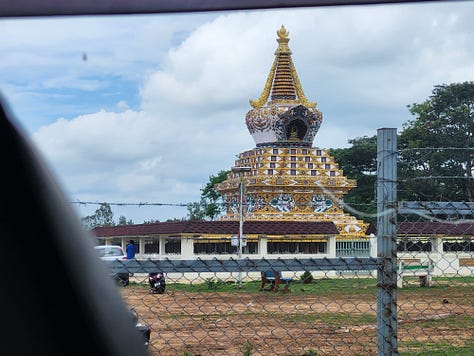

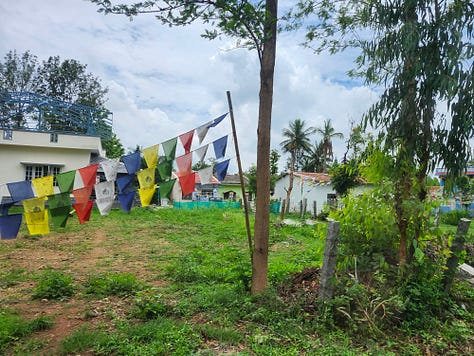
When we drove through Tibet Colony a few minutes later, its border was instantly discernible from the shift where every house started flying beautifully bright and intricate Tibetan prayer flags. The population on the streets was immediately visibly different, of ethnic Tibetan origin. I saw a traditional black-and-red Tibetan-style demon mask hanging on a field-side tree, and several Tibetan Buddhist monks wearing the maroon and gold robes that the Dalai Lama has made internationally iconic, one of them on a bicycle and carrying a black umbrella. As we left, we passed a striking Buddhist stupa. I hadn’t heard of Tibet Colony, Karnataka when I woke up that morning, but seeing it was a fascinating surprise!
The Wild Seve case was in a little village where a farmer had called in an elephant-damaged ginger crop. The local field assistant, Manoj, met us on a motorbike and led our car along tire-rutted dirt tracks to the exact location: the fields of local farmer Madan Gowda, who told the CWS team what had occurred1.
The elephant had left the forest around midnight, and reached Madan’s ginger plot around 3 AM. It just strolled around, ignoring awakened farmers’ attempts to chase it off, and trampled wide swathes of his crops in the process. The banana trees in the next field over had been damaged by an earlier elephant incursion, with several of them bent sideways or peeled open by a questing trunk. These banana trees had no fruit yet, but they did have a sweet pith at the center of their trunk which elephants found delicious.
It’s hard to blame the elephant for all this damage: the crop-stomping is the exact same “pathway-making” behavior for which we praise them as ecosystem engineers when they do it in the forest. Tiny pools in elephant footprints provide habitat for a plethora of insects, new plants spring up from their nutritious dung, dimness-dwarfed trees have a new chance to grow tall as precious life-giving light is no longer hoarded by the elephant-broken branches above them. But in a small farmer’s field, it can be a crippling loss.
And it’s very difficult to prevent. “Non-Lethally Convincing Elephants Not To Go Places Where They Want To Go” is an active area of intense research on multiple continents, and very much an unsolved problem.
Madan’s field had been surrounded by barbed wire held in place with stone fenceposts, but elephants could get through barbed wire any number of ways: stepping on the top line and crushing the fence down, using their tusks to rip it away, or even using a log as a tool to break an entry hole.
Some farms in the area have plastic “fladry” tape. The plastic gyrating and making strange unnatural noises in the wind is creepy and eldritch enough to consistently deter wild boar (and, I’d heard elsewhere, wolves in the American West). But elephants would eventually learn that plastic tape was harmless.
Some other farms in the area had solar-powered electric fences. Elephants had learned to tentatively poke fences with conduction-minimizing green leaves to check if the fences were electric. If the fences were electric, they would sometimes use their strong, flexible trunks to uproot the fenceposts by their non-conducting plastic foundations.
Beehives as barriers has found success in some locations in Africa and Asia, but in this Karnataka landscape the local cultivable bees weren’t active at night, when the elephants generally came.
In Africa, they were trying spreading spicy chili powder, but the elephants were starting to figure out ways to get around that too.
Elephants are really, really smart. Standing in the farmer’s field and looking at those gargantuan footprints, Madan and the CWS team seemed to be in agreement that the only two elephant barriers that even mostly worked were a really big, deep, and wide trench, or a really big solid-metal fence/wall. And even those, though called elephant-proof, were only mostly elephant-proof, really more “elephant-discouraging.” A sufficiently motivated elephant could probably figure out a way over, around, or through. A multi-ton animal with primate-level intelligence and opposable-thumb level dexterity made manifest in a trunk strong enough to rip up trees is really difficult to stop.
But there’s compensation, right? There is, and that’s good, but that doesn’t mean the end of the farmer’s difficulties. Submitting an application for compensation for wildlife-related damages requires a wide array of documents: the would-be claimant’s personal ID records, land records, and bank records, plus photos documenting the damage caused. Then if it’s not just property damage or crop damage but an issue of livestock damage (e.g. “tiger killed my goat”), it also requires a veterinarian’s post-mortem report confirming that a wild animal was the cause of death. This is fairly reasonable from the government’s perspective: you don’t want to create a perverse incentive and make staging wild animal attacks easier or more profitable than farming.
For the simple property or crop damage cases like the ones we saw today, CWS was able to take the photos with a smartphone and already had the relevant forms and print-outs prepared in a folder (and I believe digitally as well). They use a custom CWS platform to record data, Wild Connect, an app built over the last three years, and the Wild Seve team knows the compensation application process rather better than the backs of their hands.
But think about what it takes to assemble this for one of the poorer farmers in the area, maybe someone with just a flip-phone with no Internet or photography capability. It would require taking time off your farming to go to the local taluk headquarters just to learn what documents you need to apply, probably visiting the bank and other registries to get the documents, finding and hiring a photographer to take photos of your property, finding and hiring a vet to inspect your carcass (and you’re lucky if that’s just one day off work; all this may well end up taking many trips to town, and you’d have to leave the damage un-fixed to be photographed for this whole period), getting everyone back to your farm to document the evidence, paying the photographer (you need multiple photos, and photographers here apparently often charge by the photo), paying the vet, pulling all the results together, and then taking another trip back into town to submit the application for compensation. That often adds up to a loss even if you do receive the full compensation payment. Not just “still a loss when you count the damages done by the animal,” simply submitting the compensation application sometimes costs more than the actual compensation received!
And yet…it’s actually a pretty decent compensation system overall. Because after the application sits in a departmental to-do list for months and is processed, the money is instantly deposited in the farmer’s bank account, no extra trip to town required. If you already have the resources and information required to make the application easily, it’s a pretty frictionless system.
That’s where CWS comes in. They can be called on a toll-free number, they show up and take the photos with you. Your compensation application will be submitted within twenty-four hours of calling them, and you won’t even have to leave your farm.
All this may seem like a vertiginous descent from romantic wildlife conservation to procedure-driven bureaucratese, but this kind of thing is how Nagarhole Tiger Reserve has what’s possibly Asia’s highest density of tigers, plus roughly a thousand elephants! This is the daily legwork that makes the survival of epic wilderness strongholds within a densely populated subcontinent possible. In the Anthropocene, wild animals coexisting in human-dominated megaregions like India don’t just need a healthy ecosystem to survive, they need a healthy social, economic, and governance infrastructure to convince and incentivize humans to let them and that healthy ecosystem survive.
After a team lunch at a local restaurant (I had my Karnataka favorite, masala dosas!) we stopped at the CWS field station. I was thrilled to notice a numerous colony of large Indian flying foxes in the trees above, and would later count a minimum of 33 individuals before rain made skyward observation chancy at best.
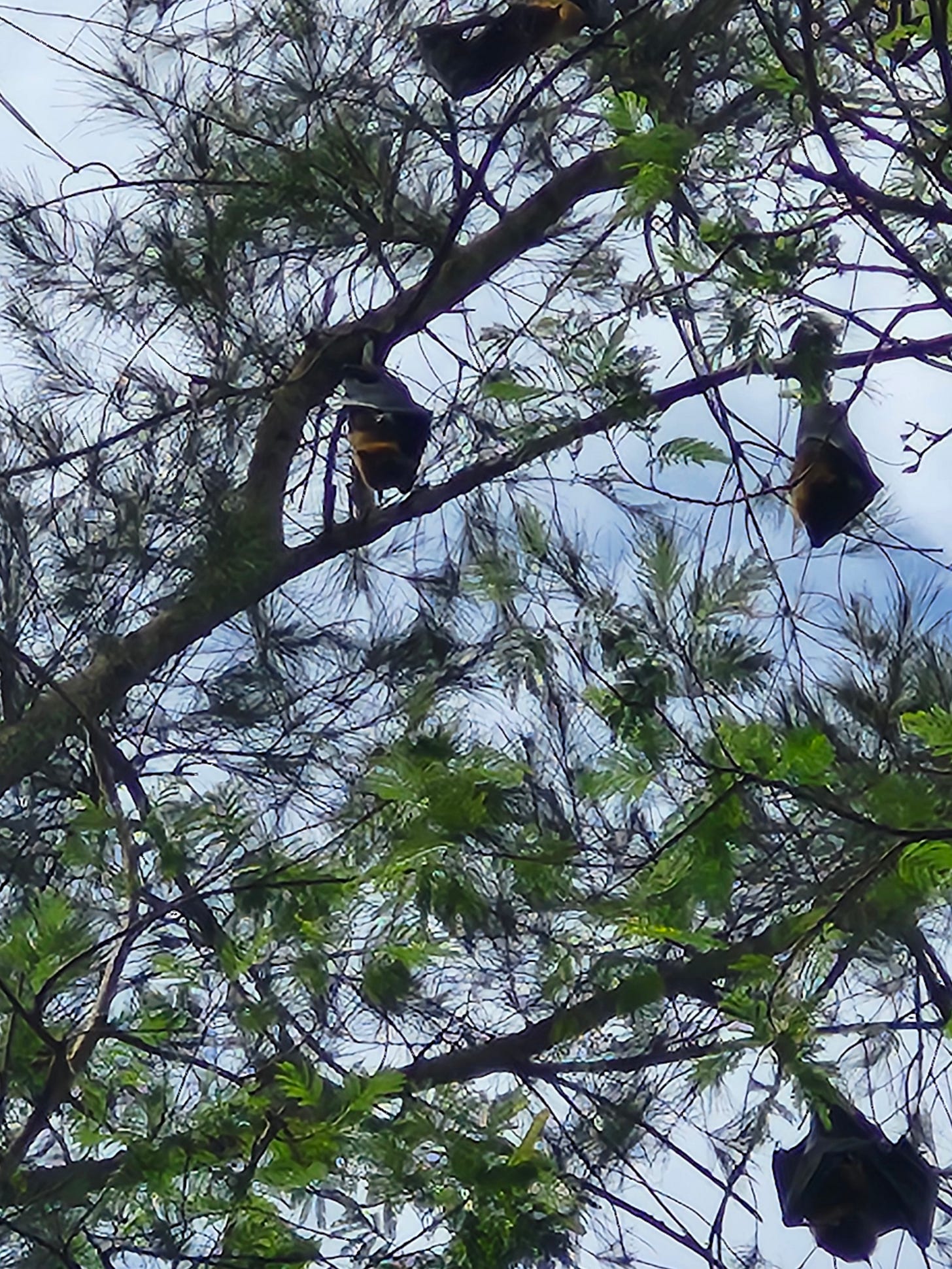
Surprised at my interest, Dhanush told me that I was more excited about these megabats than anyone else he’d ever seen. These flying foxes were not particularly beloved in the area: they were noisy, chattering like squirrels even while roosting during the daytime, and pooped a lot from above. Some people even hunted and ate them. So it often goes; there’s an old paradigm where wildlife that are highly successful in human-dominated landscapes quickly get stigmatized as “vermin,” but to me, not yet blasé about the presence of flying foxes, they were fascinating and beautiful. I’ve often thought that if common street pigeons were rare and only lived on a remote island somewhere, connoisseurs would adore their magnificent plumage with its subtle green and purple iridescences, but since urbanites see hundreds a day their beauty is ignored.
Nagachandan had work to do at the station, so in the afternoon I set off to the next case with Dhanush and C.K. The next case in the Bandipur area was in a different and drier microclimate, formed on the far side of some beautiful hills and waterbodies2. However, the specific incident was very much like the last one: an elephant had come out of the forest, crushed its way through a fence, stomped around in some fields, eaten some banana tree pith, and gone back before dawn. Dhanush knew this specific elephant of old: it often crossed the road from Bandipur towards farmers’ fields, and he had often seen its muddy footprints on the road when he’d been called out to the subsequent conflict claim cases. It was a lone male, easily identifiable as an individual thanks to the long-ago mischance that had earned it the name “One-tusker.”
Dhanush met up with the local field assistant for this area, Subhash, in an incredibly spy-movie way, driving our car alongside the field assistant’s motorcycle, exchanging wordless nods, and then following the motorcycle as it took off in the right direction, all without a sound. I had a flashback to the TV show Agents of S.H.I.E.L.D., which I’d absolutely loved as a kid; seeing the CWS organization in action gave off the same vibe of suave professionalism.
We arrived at the elephant-damaged banana field and met the farmer, Arun Rashid. Arun told the CWS team that he’d paid 250 rupees for each banana tree sibling, plus more in water and manure. He had planted 2,500 banana trees on this land (which, like Madan, Arun said had been his grandfather’s before him), and One-tusker’s late night snack raid had damaged a full 200 of them (plus some light damage to bent-out-of-shape fences and irrigation pipes on the way, mostly repaired by the time we got there).
Many of the damaged banana trees had been pulled open by a questing trunk and had their sweet pith eaten, but most had been simply sideswiped or stomped by One-tusker’s vast bulk. Eight percent of his crop was affected in one night; a major loss. But not a total loss; within an hour, the CWS team had collected all the data needed to submit his compensation application!
Next, we visited a nearby example of one of the proactive components of Wild Seve: helping farmers build predator-proof livestock sheds. As we approached, we were greeting by a friendly slingshot-bearing young boy named Sandeep. He showed us his family’s example of the traditional style of livestock shed in the area, a roof held up by posts and enclosed by light fencing. It reminded me of a beachside cabana with a toddler safety-gate around it. The baby goats inside were adorable, and human presence meant they were quite safe there during the day, but it was evident that any tiger or leopard arriving from the nearby forest at night could easily pick up a snack by ripping a hole in the fencing, or even simply jumping over the top.
Right next door was its replacement, the farm animals’ new citadel of security during the nights. The predator-proof sheds were constructed with a simple deal: CWS would provide the metal door, roof, and window bars (the costliest parts) for free, making it easier for the farmer to invest in the stone walls and foundation. Even a tool-using, trunk-equipped elephant would have trouble breaking through the resulting sturdy structure, and a tiger or leopard would be completely baffled.
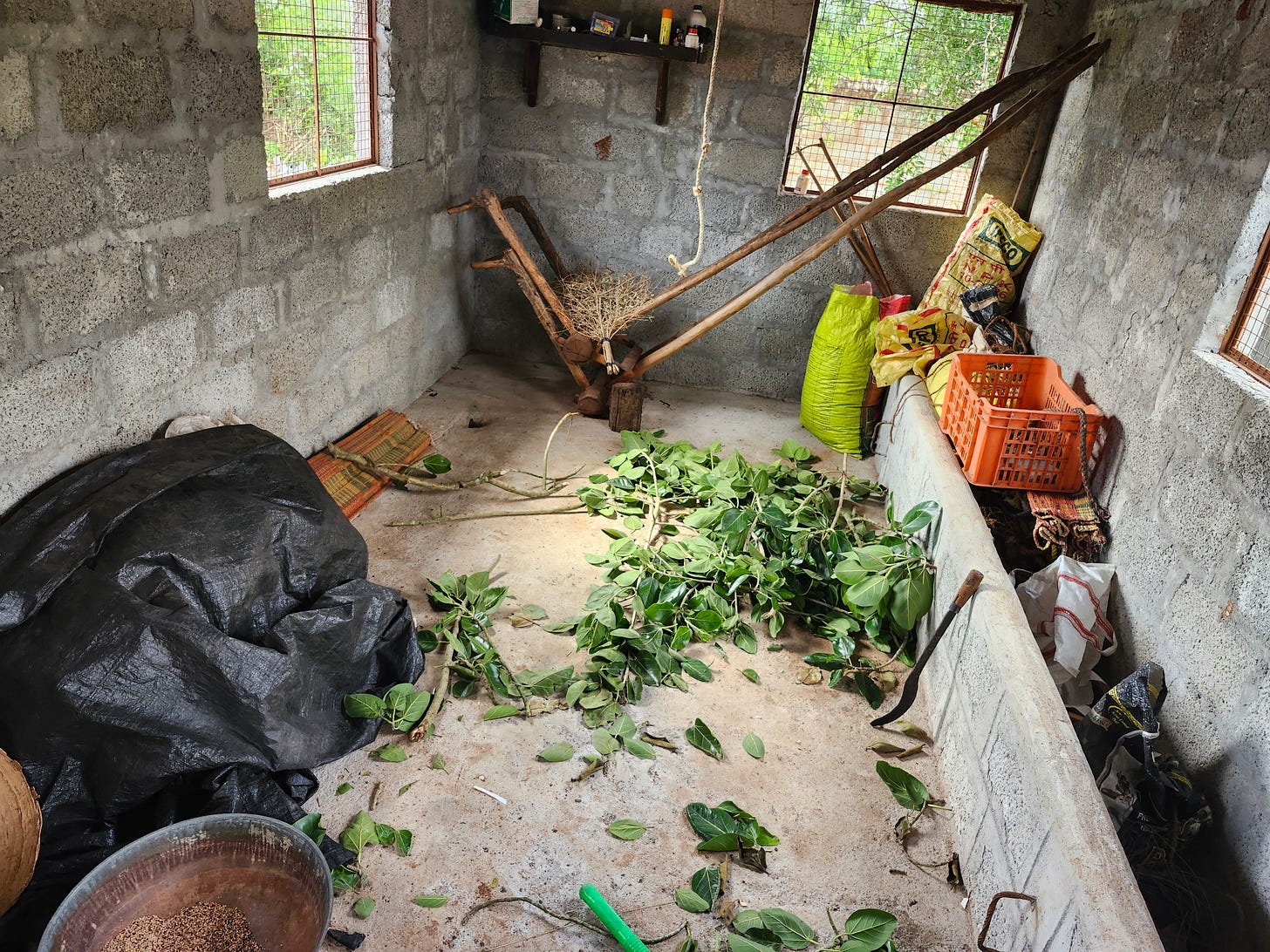
Remembering my basic ecology classes, it occurred to me that in addition to the tool-using intelligence factor, the sheer thermodynamics of the situation make it much easier to protect livestock from tigers than to protect crops from elephants. Plants like banana trees are primary producers, getting energy from sunlight, while herbivores like goats were one primary consumers one trophic level higher. It’s a rough rule of thumb that you lose 90% of biomass with each higher trophic level due to inefficiencies in consumption, so the livestock simply weighed less and were more feasibly kept in a secure building, even before getting to other obvious points like “they can be moved around more easily.”
As we left the farm with the predator-proof shed, I noticed a large tractor-like machine nearby, which Dhanush explained was for mechanically harvesting and dehusking rice grains (and/or chia seeds) en masse. From an American or European perspective, it’s easy to lump “developing countries” together, but everything I’d seen in India reminded me of just how much more developed this place was than the subsistence agriculture economy I’d lived in in rural Madagascar, and this was a particularly strong example. Improving basic agricultural productivity is one of the most critical necessities for a society to grow and prosper: more farm output with less human work means millions of people liberated from backbreaking toil at the same time that more food is being produced. Through most of human history, the vast majority of the population everywhere in the world performed agricultural labor as peasants (or worse, serfs or slaves), with the surplus used to support a small elite. Now, per Our World in Data, Madagascar has 64% of its labor force employed in agriculture, India has 43% employed in agriculture, China has 25%, and America has 1% - and American farmers aren’t peasants, but combine harvester operators and, increasingly farm-bot debuggers. The historic “rich elite” is growing to encompass more and more of humanity, as extreme poverty continues its unprecedented worldwide decline. This progress feeds on itself: a richer, more educated populace can add more economic value and afford stuff like rice-harvesting machines and tiger-proof sheds. With innovative, proactive Anthropocene-ready conservation like the work being pioneered by CWS, it’s increasingly possible to have a prosperous human civilization coexistence alongside, even interweaved with, rebounding wild ecosystems. All this might perhaps seem a tad overwrought when considered as a response to the sight of farm equipment in a Karnataka village, but it really is a tangible example of some of the most extraordinary and inspiring mega-trends shaping the future of our planet.
After such a day, I was afire with thrills of excitement and inspiration throughout the following evening at the field station. (The CWS folks had kindly let me stay the night). What I had just seen at Nagarahole and its buffer zone was, I felt, absolutely cutting-edge social technology for the Anthropocene. A superabundance of wildlife shared a rich forest ecosystem, regularly ranging into a densely populated farming zone, and yet the equilibrium was stable - wildlife populations were even growing - in part thanks to a highly functional and constantly innovating civil society efforts to make government compensation readily accessible to the people who needed it most. Anywhere in the world where humans hope to share a landscape with magnificent megafauna, local leaders could stand to look to Karnataka and the Wild Seve model to get a sense of what can be done to build a truly sustainable coexistence.
A vital first thought is to encourage the spread of the Wild Seve model in other developing countries from Indonesia to Kenya, but I think there’s also a huge amount to be learned in Europe and America, as large wildlife numbers begin an epic rebound after centuries of hunting and habitat loss. To rebuild a Western equivalent of the African Serengeti or indeed India’s Nagarahole, with lots of really large wild animals enlivening the landscape, it would be smart to stand up Wild Seve-like support structures making it as quick and easy as possible for local residents to get compensation3. If America chooses to build a new model of Anthropocene human-wildlife coexistence in the upcoming century, one with biological richness and abundance on the scale of the pre-Columbian wildlife patterns of bison ranging as far as the Appalachians and wolves as far as the Atlantic, I think we would be wise to learn from Karnataka and the Centre for Wildlife Studies.
As a side note, Madan wore a Qatar Airways branded jersey. I’ve seen those as common cheap streetwear on multiple continents now. Some advertising executive had the idea of a lifetime there.
The road towards Bandipur was lined with a beautiful tree bearing striking red-orange flowers, which Dhanush told me was called “gulmohar,” or “flame of the forest.” I later learned that the gulmohar tree is native to Madagascar and is endangered in its native range, but was introduced to India in the 1800s and is now absolutely thriving across the subcontinent! Another awesome example of an immigrant species making good.
There are many encouraging signs of broadly similar coexistence projects sprouting up already, for example the American Prairie Reserve’s Wild Sky program that Dr. Kinka discussed in our interview!





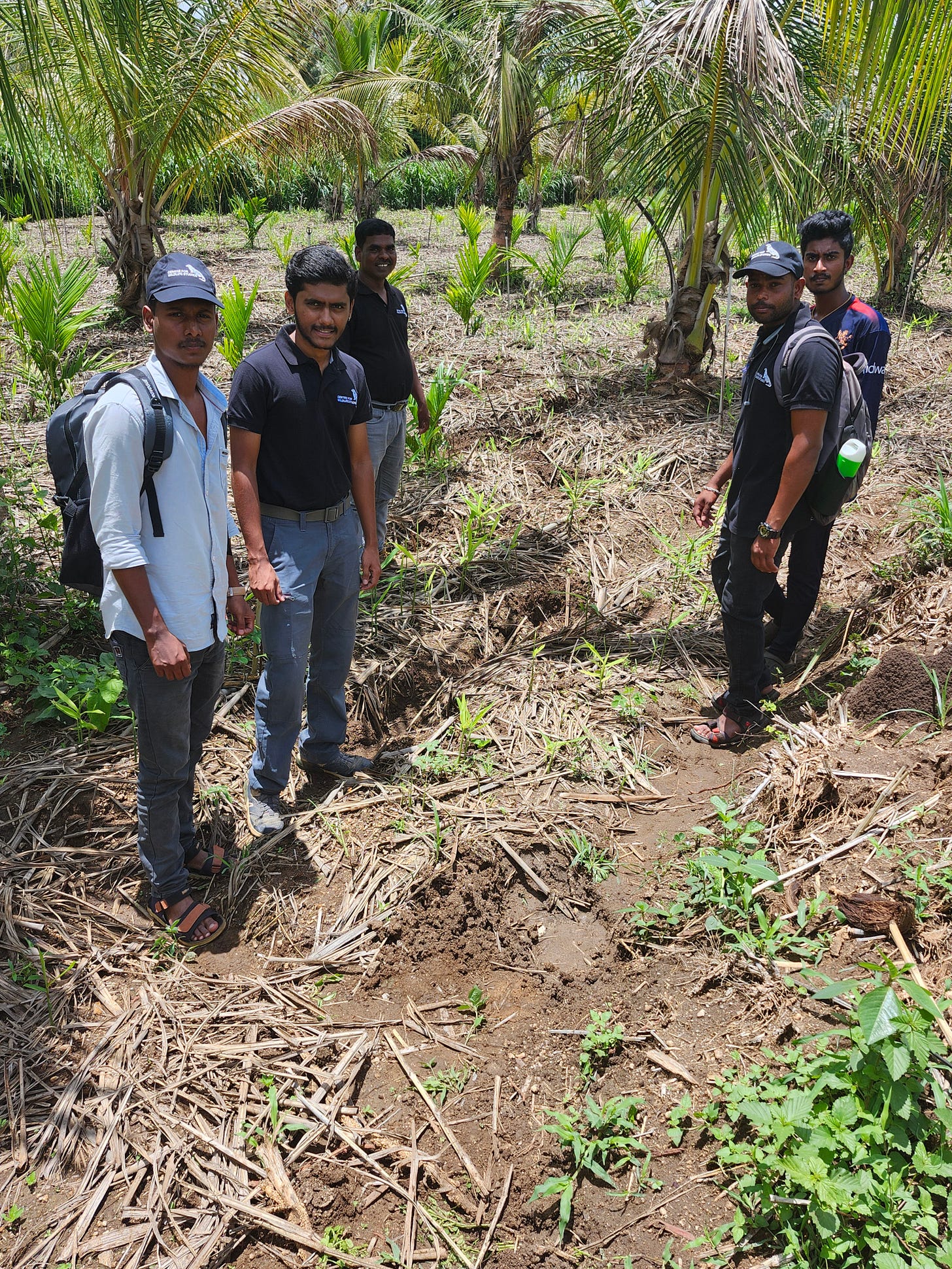
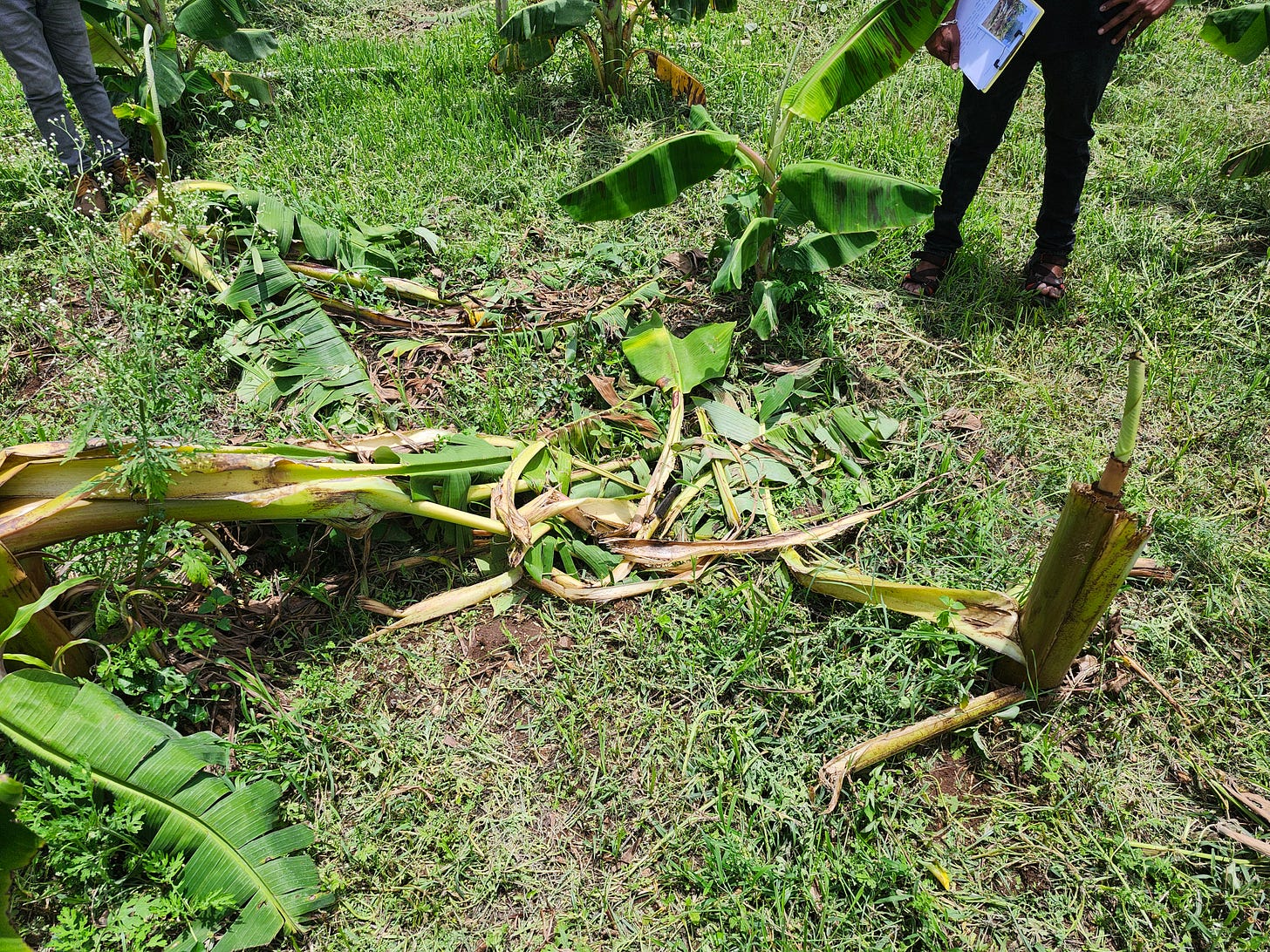
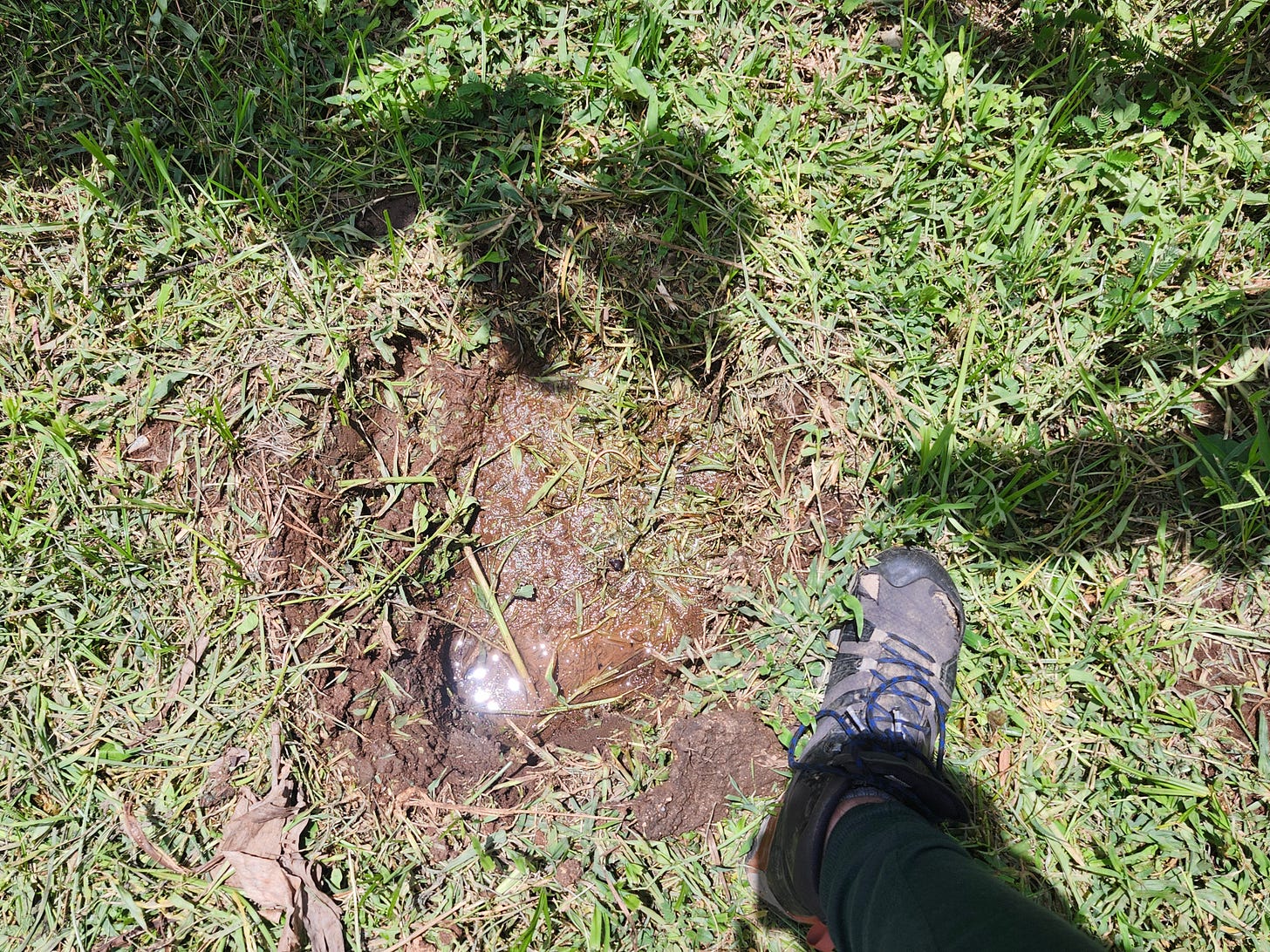

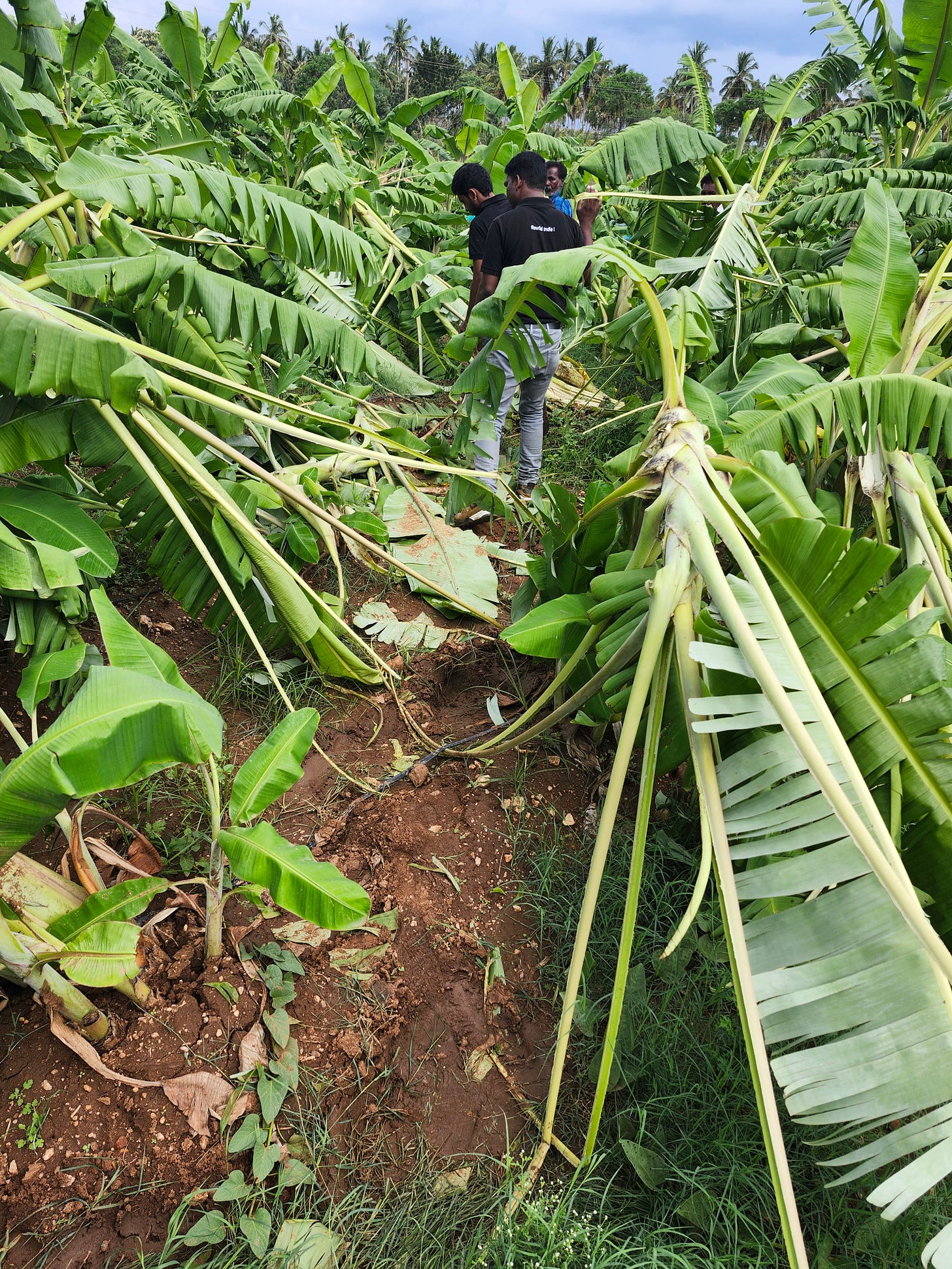

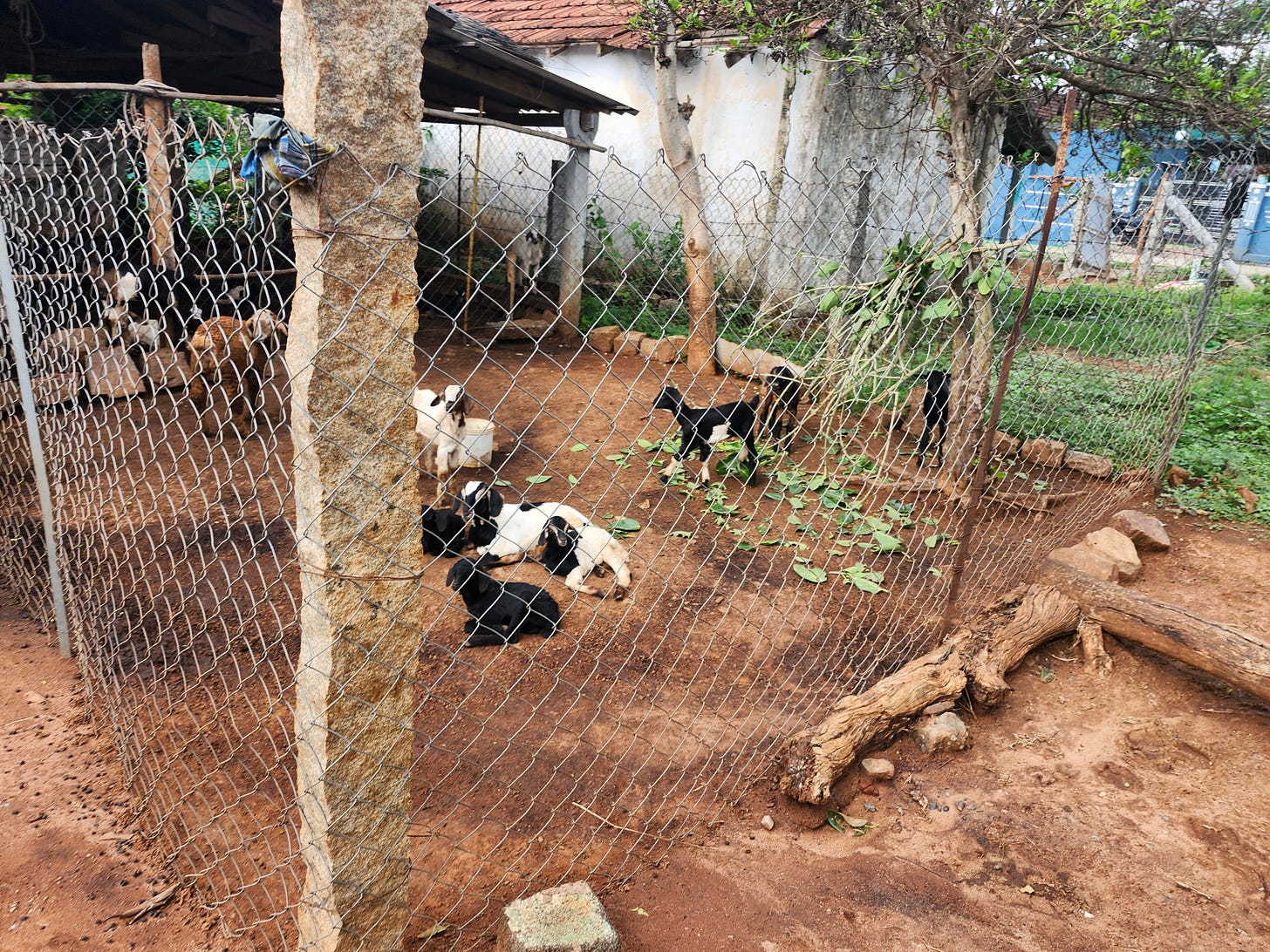
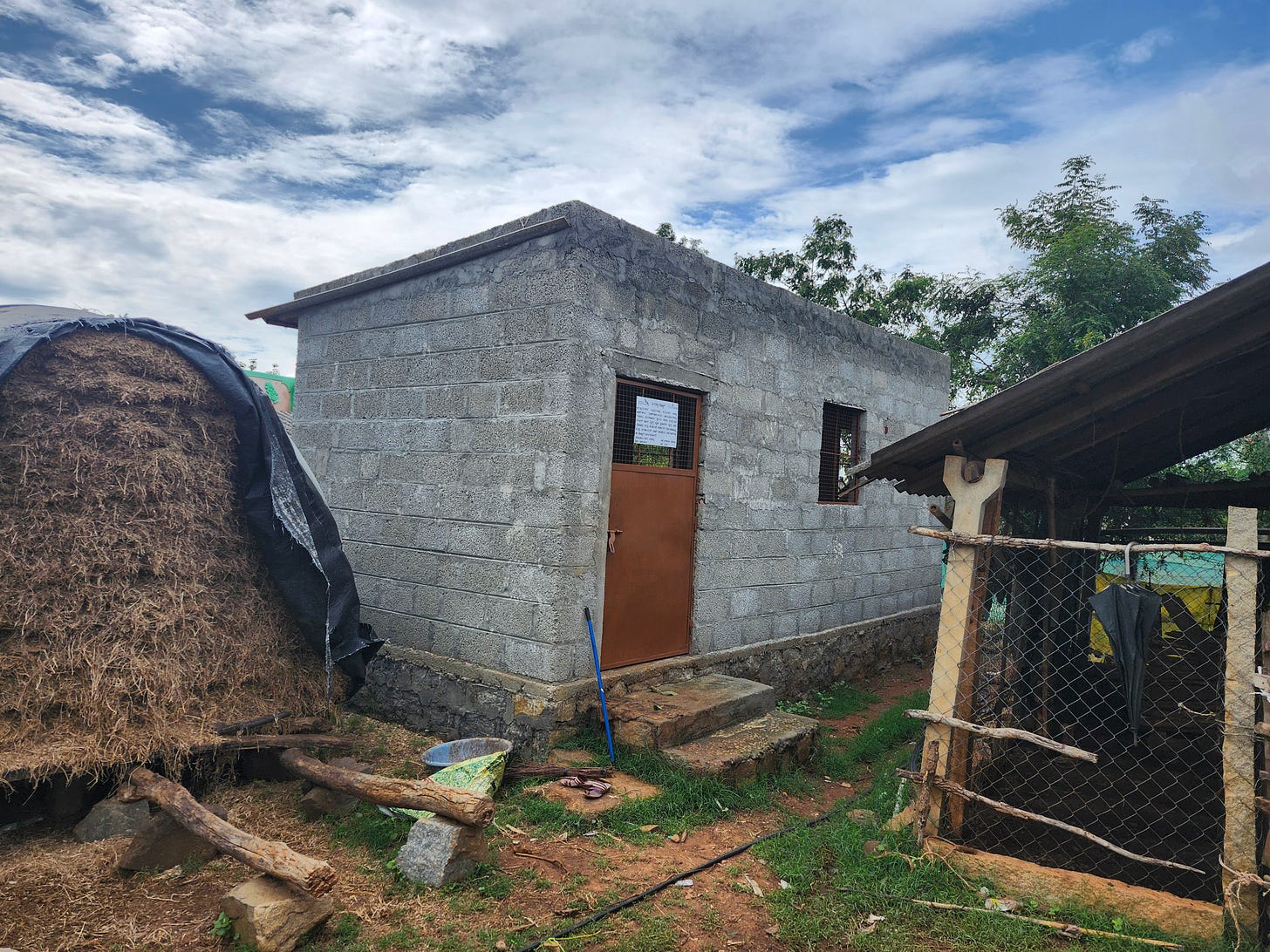
Is anyone using drones to help convince elephants to go elsewhere?
I missed this one somehow! India is just an amazing place!